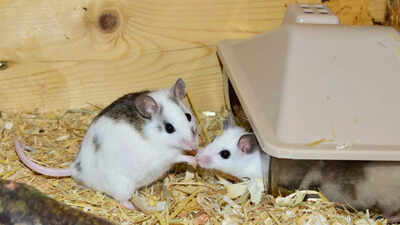Scientists have achieved a significant advancement in reproductive technology by successfully creating healthy, fertile mice using DNA from two sperm cells. This innovative approach bypasses the need for an egg and female DNA, marking a major leap in understanding same-sex parenting and genetic inheritance. These "motherless" mice not only survived to adulthood but also demonstrated their ability to reproduce.

This research has implications for understanding epigenetic programming and opens new possibilities for assisted reproduction through epigenetic techniques. The findings could have applications in biomedicine and further explore same-sex reproductive patterns.
The study, published in Nature, details how researchers used epigenetic programming to breed healthy and fertile mice using DNA from two sperm cells. Unlike previous attempts that resulted in offspring with health issues, this research produced viable pups. The team used targeted editing of methylation, a process that modifies gene expression without altering the underlying DNA sequence.
Prior research has also explored the creation of mice with two biological fathers using complex genetic engineering. This latest advancement involved overcoming biological barriers using CRISPR-Cas editing to reprogram DNA methylation. Out of 250 embryos, three pups survived, and two remained healthy and fertile, highlighting the importance of imprinting in reproduction. Scientists have successfully overcome what was previously considered insurmountable in biology.
The research team is now exploring the possibility of replicating this process with human cells. However, they emphasize that there are significant challenges to overcome, particularly regarding safety and clinical applications.
Scientists caution against direct translation of this research to humans due to the low success rate, the requirement for numerous eggs and surrogates, and the serious ethical concerns. While the study advances our understanding of genomic imprinting, its immediate application in human reproduction remains distant. The research may eventually contribute to our knowledge of infertility, embryo development, and animal conservation efforts.
Newer articles
Older articles
 Chess Star Praggnanandhaa Weighs In on Carlsen's Frustration After Loss to Gukesh
Chess Star Praggnanandhaa Weighs In on Carlsen's Frustration After Loss to Gukesh
 Samsung Galaxy A35 5G and A55 5G: Official Pricing and Availability Announced
Samsung Galaxy A35 5G and A55 5G: Official Pricing and Availability Announced
 India's Fielding Woes Blamed for First Test Defeat Against England: Former Selector Voices Concerns
India's Fielding Woes Blamed for First Test Defeat Against England: Former Selector Voices Concerns
 Headline: Viral Optical Illusion: Can You Find All the Hidden Animals? Only 1% Succeed
Headline: Viral Optical Illusion: Can You Find All the Hidden Animals? Only 1% Succeed
 Shadman Stands By Bangladesh Batters After Day 1 Struggles Against Sri Lanka
Shadman Stands By Bangladesh Batters After Day 1 Struggles Against Sri Lanka
 Norris Claims Thrilling Austrian GP Victory After Intense Duel with McLaren Teammate Piastri
Norris Claims Thrilling Austrian GP Victory After Intense Duel with McLaren Teammate Piastri
 Jake Paul's Title Dreams: Analyzing Championship Prospects and Potential Opponents
Jake Paul's Title Dreams: Analyzing Championship Prospects and Potential Opponents
 Gavaskar Urges India to Unleash Kuldeep Yadav in Second Test Amid Bumrah Fitness Concerns
Gavaskar Urges India to Unleash Kuldeep Yadav in Second Test Amid Bumrah Fitness Concerns
 iQoo Z9 Turbo Leaks: Snapdragon 8s Gen 3, 1.5K Display, and Massive Battery Detailed
iQoo Z9 Turbo Leaks: Snapdragon 8s Gen 3, 1.5K Display, and Massive Battery Detailed
 Mirabai Chanu Reveals Relentless Dedication: Training and Weight Always Top of Mind, Even During Family Time
Mirabai Chanu Reveals Relentless Dedication: Training and Weight Always Top of Mind, Even During Family Time